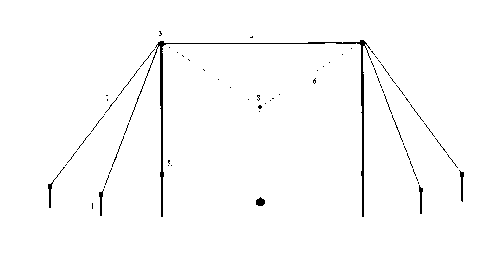Une partie des informations de ce site Web a été fournie par des sources externes. Le gouvernement du Canada n'assume aucune responsabilité concernant la précision, l'actualité ou la fiabilité des informations fournies par les sources externes. Les utilisateurs qui désirent employer cette information devraient consulter directement la source des informations. Le contenu fourni par les sources externes n'est pas assujetti aux exigences sur les langues officielles, la protection des renseignements personnels et l'accessibilité.
L'apparition de différences dans le texte et l'image des Revendications et de l'Abrégé dépend du moment auquel le document est publié. Les textes des Revendications et de l'Abrégé sont affichés :
| (12) Demande de brevet: | (11) CA 2917496 |
|---|---|
| (54) Titre français: | APPAREIL D'ENTRAINEMENT MULTI SPORT |
| (54) Titre anglais: | MULTIPLE SPORT TRAINING DEVICE |
| Statut: | Réputée abandonnée et au-delà du délai pour le rétablissement - en attente de la réponse à l’avis de communication rejetée |
| (51) Classification internationale des brevets (CIB): |
|
|---|---|
| (72) Inventeurs : |
|
| (73) Titulaires : |
|
| (71) Demandeurs : |
|
| (74) Agent: | |
| (74) Co-agent: | |
| (45) Délivré: | |
| (22) Date de dépôt: | 2016-01-13 |
| (41) Mise à la disponibilité du public: | 2017-07-13 |
| Licence disponible: | S.O. |
| Cédé au domaine public: | S.O. |
| (25) Langue des documents déposés: | Anglais |
| Traité de coopération en matière de brevets (PCT): | Non |
|---|
| (30) Données de priorité de la demande: | S.O. |
|---|
A one player sports training apparatus which allows for the user to play
multiple sports alone. The
game is played between two telescoping poles and utilizes an elastic return
system of which a ball is
attached. Each pole has a bearing assembly on top that makes it stable and
does not allow the game
to tangle. The user hits the ball and has the ball return close to the
original position because of the
elastics stretching and retracting which creates velocity. The balls used are
tennis ball, soccerball,
football, hockey puck, Frisbee, golf ball, and rugby ball.
Note : Les revendications sont présentées dans la langue officielle dans laquelle elles ont été soumises.
Note : Les descriptions sont présentées dans la langue officielle dans laquelle elles ont été soumises.

2024-08-01 : Dans le cadre de la transition vers les Brevets de nouvelle génération (BNG), la base de données sur les brevets canadiens (BDBC) contient désormais un Historique d'événement plus détaillé, qui reproduit le Journal des événements de notre nouvelle solution interne.
Veuillez noter que les événements débutant par « Inactive : » se réfèrent à des événements qui ne sont plus utilisés dans notre nouvelle solution interne.
Pour une meilleure compréhension de l'état de la demande ou brevet qui figure sur cette page, la rubrique Mise en garde , et les descriptions de Brevet , Historique d'événement , Taxes périodiques et Historique des paiements devraient être consultées.
| Description | Date |
|---|---|
| Lettre envoyée | 2023-08-21 |
| Demande de remboursement reçue | 2023-03-29 |
| Inactive : Lettre officielle | 2022-07-05 |
| Inactive : Rép. reçue: TME + surtaxe | 2022-06-01 |
| Inactive : Morte - RE jamais faite | 2022-04-06 |
| Demande non rétablie avant l'échéance | 2022-04-06 |
| Lettre envoyée | 2022-01-13 |
| Réputée abandonnée - omission de répondre à un avis sur les taxes pour le maintien en état | 2021-07-13 |
| Inactive : Lettre officielle | 2021-05-03 |
| Inactive : Rép. reçue: TME + surtaxe | 2021-04-12 |
| Réputée abandonnée - omission de répondre à un avis relatif à une requête d'examen | 2021-04-06 |
| Lettre envoyée | 2021-01-13 |
| Lettre envoyée | 2021-01-13 |
| Requête visant le maintien en état reçue | 2019-12-05 |
| Représentant commun nommé | 2019-10-30 |
| Représentant commun nommé | 2019-10-30 |
| Requête visant le maintien en état reçue | 2019-01-14 |
| Requête visant le maintien en état reçue | 2018-01-08 |
| Demande publiée (accessible au public) | 2017-07-13 |
| Inactive : Page couverture publiée | 2017-07-12 |
| Inactive : CIB attribuée | 2016-04-29 |
| Inactive : CIB attribuée | 2016-04-29 |
| Inactive : CIB en 1re position | 2016-04-29 |
| Inactive : CIB attribuée | 2016-04-29 |
| Inactive : CIB attribuée | 2016-04-29 |
| Exigences de dépôt - jugé conforme | 2016-01-20 |
| Inactive : Certificat dépôt - Aucune RE (bilingue) | 2016-01-20 |
| Demande reçue - nationale ordinaire | 2016-01-15 |
| Déclaration du statut de petite entité jugée conforme | 2016-01-13 |
| Date d'abandonnement | Raison | Date de rétablissement |
|---|---|---|
| 2021-07-13 | ||
| 2021-04-06 |
Le dernier paiement a été reçu le 2019-12-05
Avis : Si le paiement en totalité n'a pas été reçu au plus tard à la date indiquée, une taxe supplémentaire peut être imposée, soit une des taxes suivantes :
Veuillez vous référer à la page web des taxes sur les brevets de l'OPIC pour voir tous les montants actuels des taxes.
| Type de taxes | Anniversaire | Échéance | Date payée |
|---|---|---|---|
| Taxe pour le dépôt - petite | 2016-01-13 | ||
| TM (demande, 2e anniv.) - petite | 02 | 2018-01-15 | 2018-01-08 |
| TM (demande, 3e anniv.) - petite | 03 | 2019-01-14 | 2019-01-14 |
| TM (demande, 4e anniv.) - petite | 04 | 2020-01-13 | 2019-12-05 |
| 2021-04-12 | 2021-04-12 |
Les titulaires actuels et antérieures au dossier sont affichés en ordre alphabétique.
| Titulaires actuels au dossier |
|---|
| ERME ERIC EDWARD |
| Titulaires antérieures au dossier |
|---|
| S.O. |